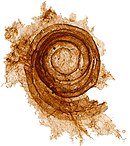| Cochleatina Temporal range: Ediacaran – Fortunian PreꞒ Ꞓ O S D C P T J K Pg N | |
|---|---|

| |
| Cochleatina canilovica | |
| Scientific classification | |
| (unranked): | incertae sedis |
| Genus: | †Cochleatina Aseeva, 1974 |
Cochleatina is an organic-walled microfossil ('Small Carbonaceous Fossil') known from the late Ediacaran period and early Cambrian Fortunian Stage. Cochleatina comprises a complex spiral ribbon structure, with a serrated outer margin. These spirals are frequently found embedded in an organic sheet. Cochleatina is a rare example of a fossil taxon known to span the Ediacaran–Cambrian boundary.
Affinity
Cochleatina's biological affinity is unknown. It has been variously regarded as the fossil remains of an animal, an algae, or a protist.
References
- ^ Slater, Ben J.; Harvey, Thomas H. P.; Bekker, Andrey; Butterfield, Nicholas J. (2020). "Cochleatina: an enigmatic Ediacaran–Cambrian survivor among small carbonaceous fossils (SCFs)". Palaeontology. 63 (5): 733–752. Bibcode:2020Palgy..63..733S. doi:10.1111/pala.12484. ISSN 1475-4983.
- "New information on the Ediacaran–Cambrian transition in the Vestertana Group, Finnmark, northern Norway, from trace fossils and organic-walled microfossils" (PDF). Archived from the original (PDF) on 2017-02-02. Retrieved 2017-01-23.
{{cite journal}}: Cite journal requires|journal=(help) - Organic-walled microfossils from the Ediacaran-Cambrian Global Boundary Stratotype Section, Chapel Island and Random formations, Newfoundland, Canada (PDF).
This Ediacaran biota-related article is a stub. You can help Misplaced Pages by expanding it. |
This article related to the Cambrian period is a stub. You can help Misplaced Pages by expanding it. |